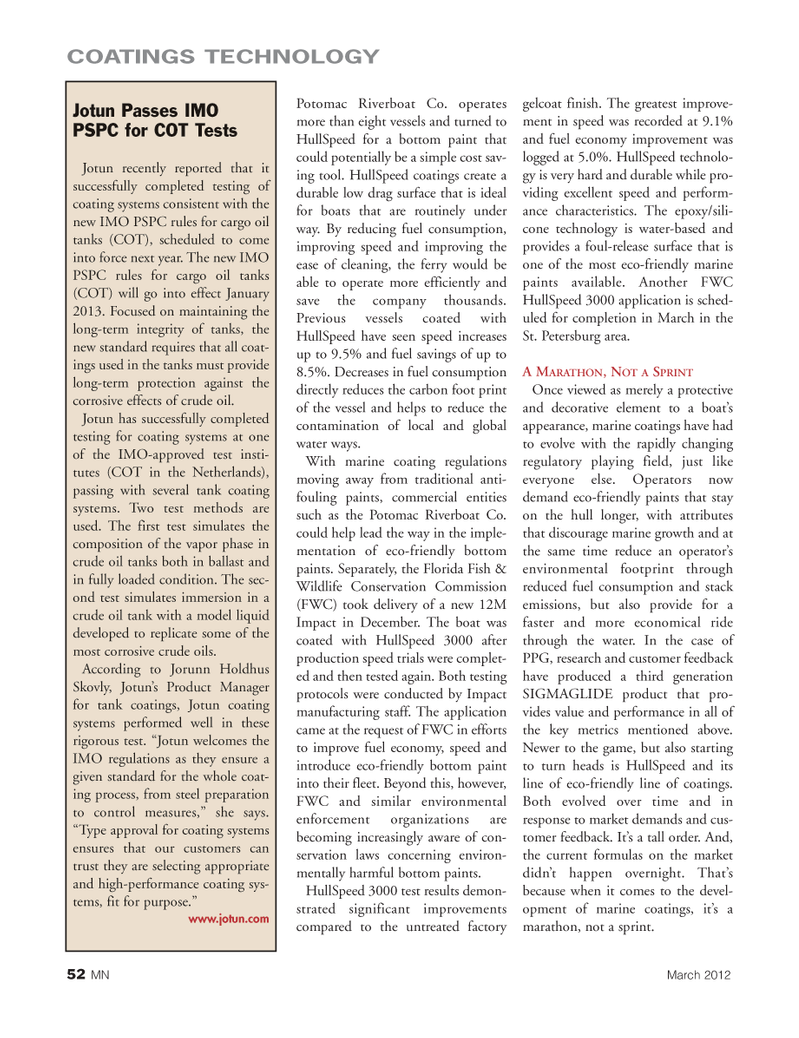
Page 52: of Marine News Magazine (March 2012)
Training & Education
Read this page in Pdf, Flash or Html5 edition of March 2012 Marine News Magazine
52MNMarch 2012 Potomac Riverboat Co. operates more than eight vessels and turned to HullSpeed for a bottom paint that could potentially be a simple cost sav-ing tool. HullSpeed coatings create a durable low drag surface that is ideal for boats that are routinely under way. By reducing fuel consumption, improving speed and improving the ease of cleaning, the ferry would be able to operate more efficiently and save the company thousands. Previous vessels coated with HullSpeed have seen speed increases up to 9.5% and fuel savings of up to8.5%. Decreases in fuel consumption directly reduces the carbon foot print of the vessel and helps to reduce the contamination of local and globalwater ways. With marine coating regulations moving away from traditional anti- fouling paints, commercial entities such as the Potomac Riverboat Co. could help lead the way in the imple-mentation of eco-friendly bottompaints. Separately, the Florida Fish & Wildlife Conservation Commission (FWC) took delivery of a new 12M Impact in December. The boat was coated with HullSpeed 3000 after production speed trials were complet- ed and then tested again. Both testingprotocols were conducted by Impact manufacturing staff. The application came at the request of FWC in efforts to improve fuel economy, speed and introduce eco-friendly bottom paint into their fleet. Beyond this, however, FWC and similar environmental enforcement organizations are becoming increasingly aware of con- servation laws concerning environ- mentally harmful bottom paints. HullSpeed 3000 test results demon- strated significant improvements compared to the untreated factory gelcoat finish. The greatest improve- ment in speed was recorded at 9.1% and fuel economy improvement was logged at 5.0%. HullSpeed technolo- gy is very hard and durable while pro- viding excellent speed and perform- ance characteristics. The epoxy/sili- cone technology is water-based andprovides a foul-release surface that is one of the most eco-friendly marinepaints available. Another FWC HullSpeed 3000 application is sched- uled for completion in March in the St. Petersburg area. A MARATHON , NOTA SPRINTOnce viewed as merely a protective and decorative element to a boat?s appearance, marine coatings have had to evolve with the rapidly changing regulatory playing field, just like everyone else. Operators now demand eco-friendly paints that stayon the hull longer, with attributes that discourage marine growth and at the same time reduce an operator?s environmental footprint through reduced fuel consumption and stack emissions, but also provide for a faster and more economical ride through the water. In the case of PPG, research and customer feedback have produced a third generation SIGMAGLIDE product that pro- vides value and performance in all of the key metrics mentioned above. Newer to the game, but also starting to turn heads is HullSpeed and its line of eco-friendly line of coatings.Both evolved over time and in response to market demands and cus- tomer feedback. It?s a tall order. And, the current formulas on the market didn?t happen overnight. That?s because when it comes to the devel- opment of marine coatings, it?s a marathon, not a sprint.Jotun Passes IMOPSPC for COT Tests Jotun recently reported that it successfully completed testing ofcoating systems consistent with thenew IMO PSPC rules for cargo oil tanks (COT), scheduled to come into force next year. The new IMO PSPC rules for cargo oil tanks (COT) will go into effect January 2013. Focused on maintaining the long-term integrity of tanks, thenew standard requires that all coat- ings used in the tanks must provide long-term protection against the corrosive effects of crude oil. Jotun has successfully completed testing for coating systems at oneof the IMO-approved test insti- tutes (COT in the Netherlands), passing with several tank coating systems. Two test methods are used. The first test simulates the composition of the vapor phase in crude oil tanks both in ballast and in fully loaded condition. The sec- ond test simulates immersion in acrude oil tank with a model liquid developed to replicate some of the most corrosive crude oils. According to Jorunn Holdhus Skovly, Jotun?s Product Manager for tank coatings, Jotun coating systems performed well in these rigorous test. ?Jotun welcomes the IMO regulations as they ensure a given standard for the whole coat- ing process, from steel preparation to control measures,? she says. ?Type approval for coating systems ensures that our customers can trust they are selecting appropriate and high-performance coating sys- tems, fit for purpose.? www.jotun.com COATINGS TECHNOLOGY MN#3 (50-58):MN 2011 Layouts 3/5/2012 1:40 PM Page 52

 51
51

 53
53
